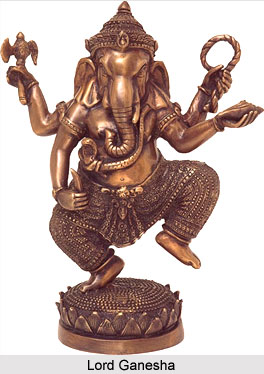 In the form of Ganadhyaksa, Lord Ganesha is worshipped as the leader of the Ganas (Bhutaganas), the celestial army of Lord Shiva. He was designated as the leader by his father Shiva himself. Ganadhyaksa is the tenth form among the 12 forms of Lord Ganesha, as mentioned in the various Mahapuranas and the Upapuranas, such as Linga Purana, Ganesha Purana, Mudgala Purana, Shiva Purana and Brahmavaivarta Purana. Each of the forms of the deity portrays distinctive characteristics of Lord Ganesha. Ganesha is also known as Ganapati.
In the form of Ganadhyaksa, Lord Ganesha is worshipped as the leader of the Ganas (Bhutaganas), the celestial army of Lord Shiva. He was designated as the leader by his father Shiva himself. Ganadhyaksa is the tenth form among the 12 forms of Lord Ganesha, as mentioned in the various Mahapuranas and the Upapuranas, such as Linga Purana, Ganesha Purana, Mudgala Purana, Shiva Purana and Brahmavaivarta Purana. Each of the forms of the deity portrays distinctive characteristics of Lord Ganesha. Ganesha is also known as Ganapati.
Legends Related to Ganadhyaksa
As Ganadhyaksa, the Lord is regarded as the leader of all the Ganas, attendants of Shiva, and the master of all the elements. Legends mention that after He was decapitated by his father Lord Shiva, Ganesha was transplanted with head of an elephant. Thus He regained back his life. After that Shiva appointed Him as the leader to his ghostly army. The Ganas started dancing with this announcement.
Ganadhyaksa conveys 2 different meanings. The first portrays Ganesha as the Swami or master of all the materialistic things that can be counted. The other meaning depicts the Lord as the controller of Ganas. He is also the master and leader (Swami) of men (Nar), demons (Asuras), snakes (Nagas), the four Vedas (Chaturveda) and the four Purusharthas. Ganesha is considered as the master of the entire universe (Lord Bramha) Thus he is known as Ganapati or Ganancha Adhipati.
This article is a stub. You may enrich it by adding more information to it. You can send your write-up at content@indianetzone.com




















